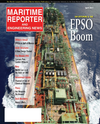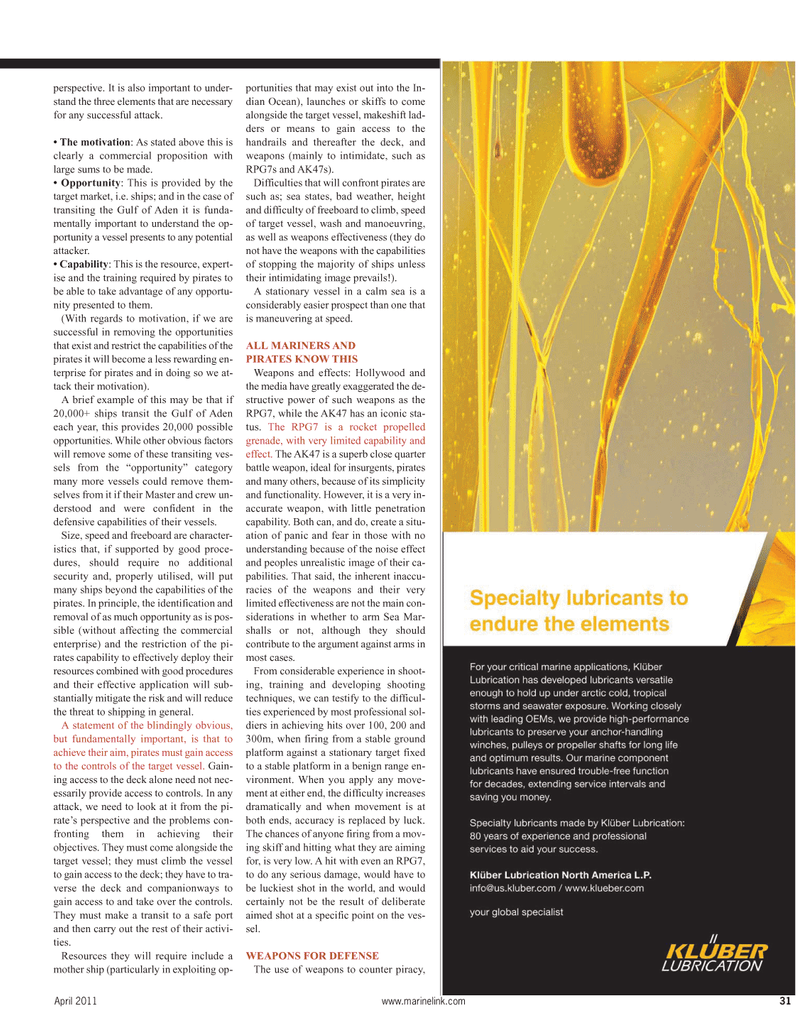
Page 31: of Maritime Reporter Magazine (April 2011)
Offshore Annual
Read this page in Pdf, Flash or Html5 edition of April 2011 Maritime Reporter Magazine
April 2011 www.marinelink.com 31 perspective. It is also important to under- stand the three elements that are necessary for any successful attack. • The motivation: As stated above this is clearly a commercial proposition with large sums to be made. • Opportunity: This is provided by the target market, i.e. ships; and in the case of transiting the Gulf of Aden it is funda- mentally important to understand the op- portunity a vessel presents to any potential attacker. • Capability: This is the resource, expert- ise and the training required by pirates to be able to take advantage of any opportu- nity presented to them. (With regards to motivation, if we are successful in removing the opportunities that exist and restrict the capabilities of the pirates it will become a less rewarding en- terprise for pirates and in doing so we at- tack their motivation).
A brief example of this may be that if 20,000+ ships transit the Gulf of Aden each year, this provides 20,000 possible opportunities. While other obvious factors will remove some of these transiting ves- sels from the “opportunity” category many more vessels could remove them- selves from it if their Master and crew un- derstood and were confident in the defensive capabilities of their vessels.
Size, speed and freeboard are character- istics that, if supported by good proce- dures, should require no additional security and, properly utilised, will put many ships beyond the capabilities of the pirates. In principle, the identification and removal of as much opportunity as is pos- sible (without affecting the commercial enterprise) and the restriction of the pi- rates capability to effectively deploy their resources combined with good procedures and their effective application will sub- stantially mitigate the risk and will reduce the threat to shipping in general.
A statement of the blindingly obvious, but fundamentally important, is that to achieve their aim, pirates must gain access to the controls of the target vessel. Gain- ing access to the deck alone need not nec- essarily provide access to controls. In any attack, we need to look at it from the pi- rate’s perspective and the problems con- fronting them in achieving their objectives. They must come alongside the target vessel; they must climb the vessel to gain access to the deck; they have to tra- verse the deck and companionways to gain access to and take over the controls.
They must make a transit to a safe port and then carry out the rest of their activi- ties.
Resources they will require include a mother ship (particularly in exploiting op- portunities that may exist out into the In- dian Ocean), launches or skiffs to come alongside the target vessel, makeshift lad- ders or means to gain access to the handrails and thereafter the deck, and weapons (mainly to intimidate, such as
RPG7s and AK47s).
Difficulties that will confront pirates are such as; sea states, bad weather, height and difficulty of freeboard to climb, speed of target vessel, wash and manoeuvring, as well as weapons effectiveness (they do not have the weapons with the capabilities of stopping the majority of ships unless their intimidating image prevails!).
A stationary vessel in a calm sea is a considerably easier prospect than one that is maneuvering at speed.
ALL MARINERS AND
PIRATES KNOW THIS
Weapons and effects: Hollywood and the media have greatly exaggerated the de- structive power of such weapons as the
RPG7, while the AK47 has an iconic sta- tus. The RPG7 is a rocket propelled grenade, with very limited capability and effect. The AK47 is a superb close quarter battle weapon, ideal for insurgents, pirates and many others, because of its simplicity and functionality. However, it is a very in- accurate weapon, with little penetration capability. Both can, and do, create a situ- ation of panic and fear in those with no understanding because of the noise effect and peoples unrealistic image of their ca- pabilities. That said, the inherent inaccu- racies of the weapons and their very limited effectiveness are not the main con- siderations in whether to arm Sea Mar- shalls or not, although they should contribute to the argument against arms in most cases.
From considerable experience in shoot- ing, training and developing shooting techniques, we can testify to the difficul- ties experienced by most professional sol- diers in achieving hits over 100, 200 and 300m, when firing from a stable ground platform against a stationary target fixed to a stable platform in a benign range en- vironment. When you apply any move- ment at either end, the difficulty increases dramatically and when movement is at both ends, accuracy is replaced by luck.
The chances of anyone firing from a mov- ing skiff and hitting what they are aiming for, is very low. A hit with even an RPG7, to do any serious damage, would have to be luckiest shot in the world, and would certainly not be the result of deliberate aimed shot at a specific point on the ves- sel.
WEAPONS FOR DEFENSE
The use of weapons to counter piracy,

 30
30

 32
32
